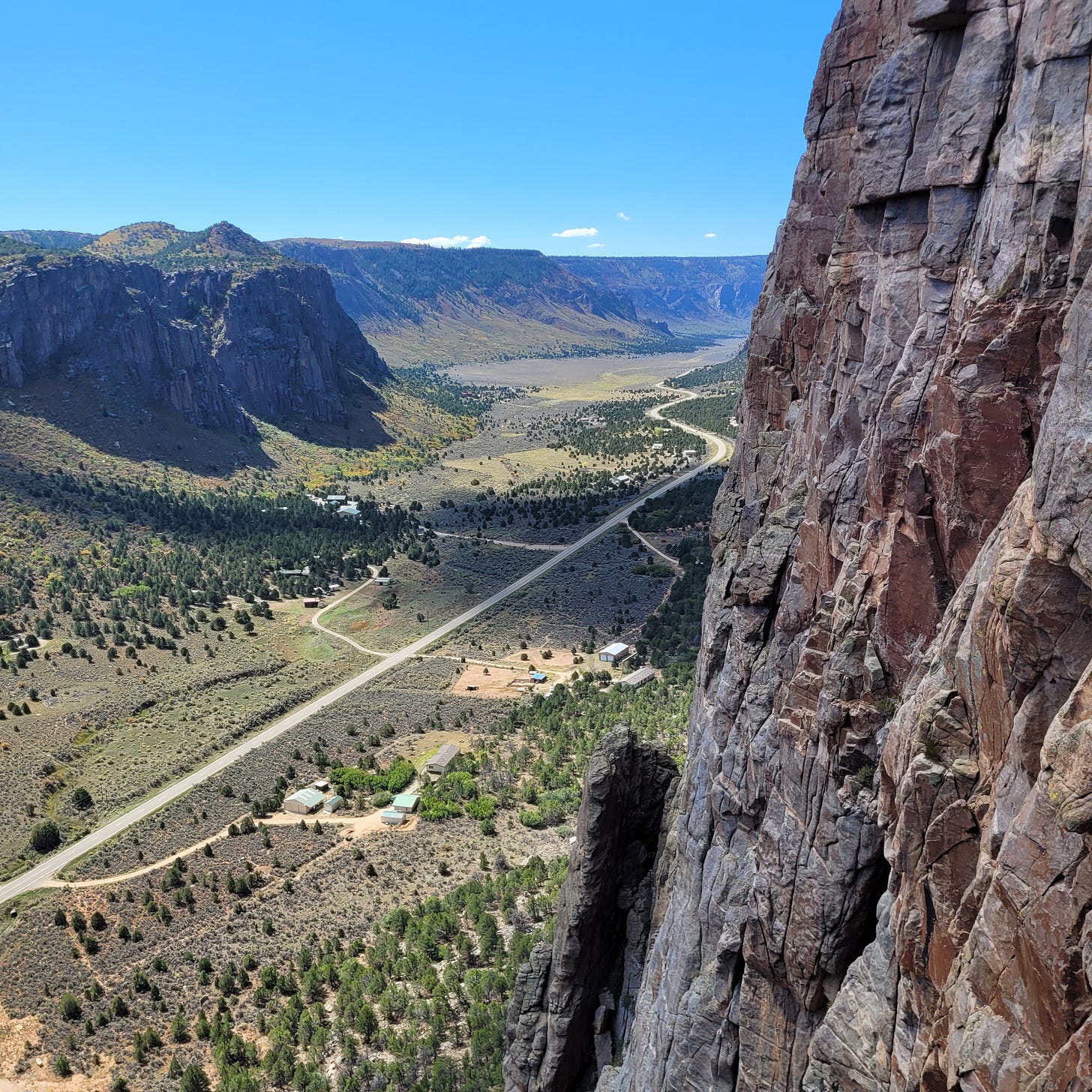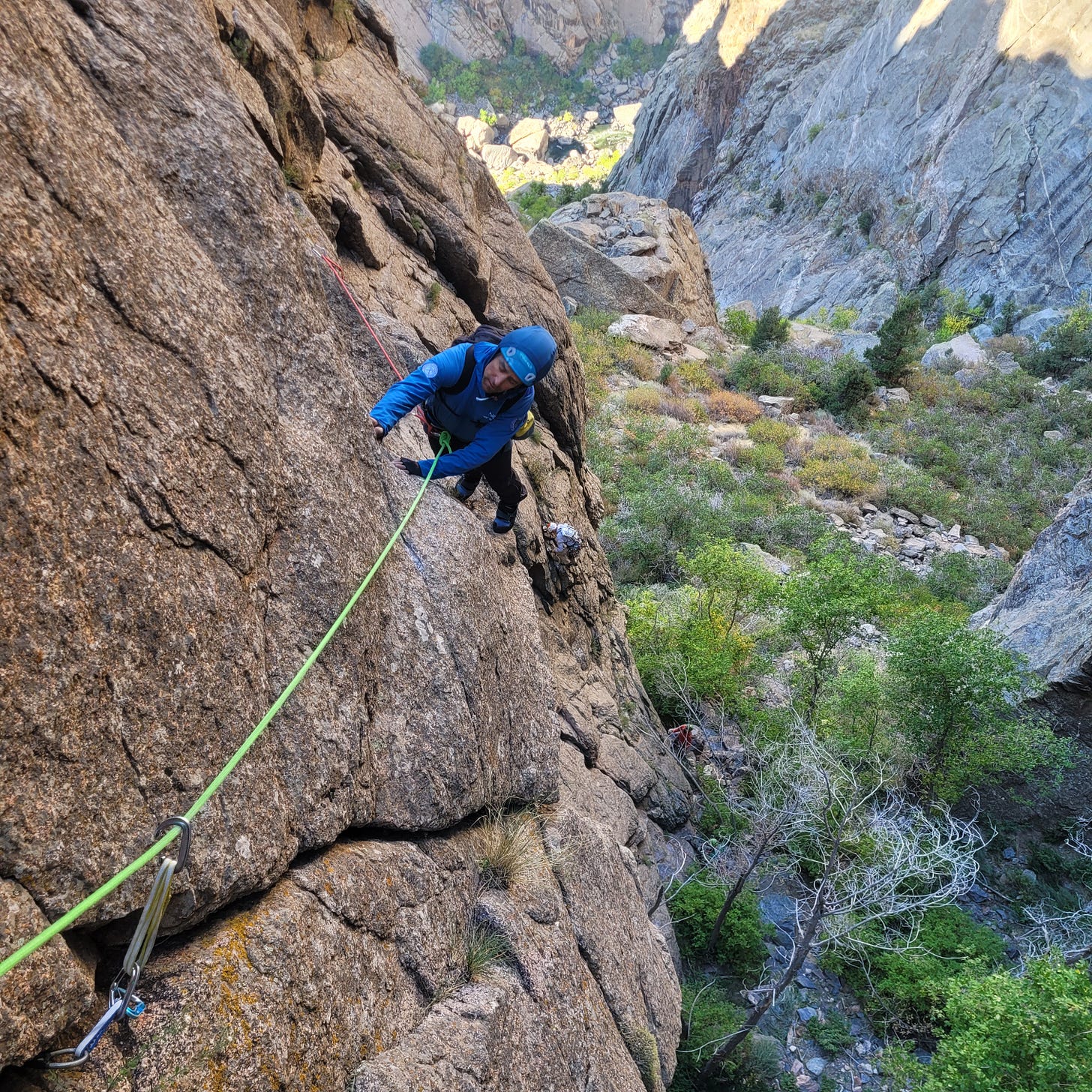I am an Assistant Rock Guide Now! (sort of)
Debriefing my Advanced Rock Guide Course with the American Mountain Guides Association
Earlier this month, I participated in my eight-day Advanced Rock Guide Course and Aspirant Exam with the American Mountain Guides Association (AMGA). The course was based on the Western Slope of Colorado and included three different venues: Unaweep Canyon, Rifle Mountain Park, and the Black Canyon of the Gunnison National Park. My instructors were Vince Anderson, Mike Soucy, and Patrick Ormond (a powerhouse trio).
My Course was Well-Balanced
My course was well-balanced and highly productive thanks to the three different venues (and the wonderful, sunny, and dry weather). In Unaweep, we blasted up splitter granite crack systems and battled through blue-collar jamming sequences. In Rifle, we tested our onsighting skills on the hard-to-read stone and utilized advanced climbing techniques to unlock cryptic beta. And in the Black, we deployed all the above to ascend massive multi-pitch routes.
Unaweep Canyon
Unaweep Canyon is located about 30 minutes south of Grand Junction, Colorado. Its name, Unaweep, comes from the Ute language and translates to “canyon with two mouths.” The canyon with two mouths is filled to the absolute brim with climbing, including sandstone bouldering, bolted single-pitch sport climbs, and multi-pitch traditional crack climbs.
Rifle Mountain Park
Talk to any sport climber, and they will have either heard of Rifle Mountain Park or climbed in Rifle. That’s because Rifle is one of North America’s premier sport climbing destinations. Prior to my course, I identified as the former. Now, after my course, I am the latter and thrilled to have tested my mettle on Rifle’s iconic limestone cliffs.
Black Canyon of the Gunnison

Despite being a National Park, the Black Canyon of the Gunnison flies significantly under the radar. People are surprised when they learn that the canyon walls within the belly of the Black boast some of the largest pieces of rock in the country. At its deepest point, the Black plunges 2,722 feet deep (830 meters). The tallest vertical wall in the Black is the Painted Wall, 2,250 ft (686 meters), which is almost as tall as El Capitan in Yosemite.
My Favorite Learning Moments
Every day of the course, there were valuable learning moments. It’s amazing what three highly skilled instructors (and six motivated students) can accomplish. That being said, there are a few things I learned and practiced that stand out from the rest.
Backpack Hauling
On longer rock climbs, it’s common to wear a small backpack while climbing, especially for the guide. The guide’s pack includes personal items, like food, water, and extra layers, as well as group gear, like a first aid kit or a particular piece of equipment. The clients carry similar items in their backpacks.
Whatever is necessary to remain fed, hydrated, warm, and dry throughout the climb goes in the pack. (And maybe some “oh shit” or emergency supplies, like a satellite phone, headlamp, a lighter, and a knife.)
In many cases, climbing with a backpack is no big deal. Sure, it’s extra weight, but guiding objectives typically have wide margins for error, whereby a backpack is not make or break.
Nonetheless, there are moments on a rock climb where a backpack is obviously cumbersome.
off-width climbing, like in a chimney system
hard crux climbing, whereby the extra weight and limited mobility may inhibit ascent
In these scenarios, being able to haul backpacks efficiently dramatically enhances the overall climbing experience. So, learning where and when to haul backpacks and the different ways you can accomplish the task was super insightful.
Parallel Rope Transitions
One of the main learning objectives of the advanced course is becoming familiar with parallel rope systems. In a parallel rope system, the guide manages two ropes to belay two climbers simultaneously. A parallel rope system has many advantages, primarily because it’s fast. However, there are some drawbacks to parallel systems, mainly that managing ropes is harder than one, especially at transition points.
Therefore, we spent a lot of time with parallel rope transitions, such as:
transitioning from parallel to a pre-rigged rappel
transitioning into a lowering system
transitioning from a parallel system into a short-roping or short-pitching system
In all of these transitions, the main takeaway from me was learning how to use the rope as much as possible (like for tethering climbers and building anchors). In addition, I really enjoyed learning how to formulaically plan ahead for the transition so that everyone and everything is positioned in the ideal spots depending on what the terrain calls for.
Short-Roping and Short-Pitching
Short-roping and short-pitching are techniques in which you utilize a short length of the climbing rope to add security during the approach or during the walk-off from a rock climb (e.g., giving a quick belay either with your hand, body, terrain feature, or belay device).
For example, to get off climbs in Unaweep Canyon, scrambling in third- and fourth-class terrain is typical. Similarly, to approach climbs in the Black Canyon, you have to descend gulley systems that might contain some exposed scrambling or rappels.
Therefore, you can short-rope to add security to prevent slips or trips from evolving into full-blown falls. Similarly, when there’s a short but easy section of fourth-class scrambling where a fall could be catastrophic, you can short-pitch and provide a belay just in case.
Learning when to add security for clientele and how to add security was super eye-opening for me. In particular, learning how to identify terrain features, like boulders, horns, and trees, to provide a super secure and efficient belay was super eye-opening.
Using terrain in short-roping and short-pitching scenarios is commonly referred to as “black magic” amongst guides, and now I am beginning to understand why. Seeing someone skillfully manipulate and navigate short-roping terrain is akin to a magician performing magic. Trying it yourself is infinitely more complex.
Unfortunately, My Course Wasn’t all Good
Out of the eight days, I operated at a super high level for seven. Or maybe even seven and a half. I climbed super well, was focused, participated in conversation, took notes, asked good questions, coached and instructed well, and even cracked a few good jokes. But unfortunately, I let things spiral during one of the afternoons.
Performance Anxiety During the Rock Rescue Drill (RRD)
I was feeling good leading up to the RRD. I had been practicing a lot and knew the drill well. I even did a triumphant practice lap with another student the day before the course started. But things fell apart when the instructor sat down to observe my drill and started the stopwatch (you have to finish in 50 minutes or less).
In summary, I made several small mistakes that cost me the drill. Nothing I did was catastrophically wrong or unsafe. It’s just that the error correction I forced myself to make at multiple junctures during the drill cost me a lot of time.
I made some of the same mistakes during the actual drill as I did in preparation the months before the course. But what was interesting was that at least one mistake was brand new for me. Committing this new mistake was the final nail in the coffin that made me fail the drill.
Looking back, I attribute my clumsy rescue drill to feeling overwhelmed by what I can only describe as performance anxiety. In addition, I attribute some of my anxiety to an intimidating, poorly timed interaction with one of my instructors moments before the drill started. Without getting too caught up in the details, I returned from the interaction feeling rattled and suddenly unconfident in the skills I was about to perform. From there, things spiraled.

My Next Steps
Despite receiving a positive evaluation from my instructors and passing the other exam portions of the course, I still feel pretty rotten and embarrassed about having to leave the course with an “incomplete” status. As a consolation, I am not the only one. Unfortunately, another student did not pass the drill. In addition, two other students finished with less than 60 seconds left on the clock.
I now have to hire a local AMGA instructor team member for an additional day so we can run another RRD. (Hopefully, this time with less pressure.)
Fortunately, I should be able to accomplish that here in the Gunks. Besides doing a second RRD, I can use the day as another learning experience and a valuable opportunity to receive mentorship from a highly skilled guide. It will be like adding a ninth day to my Advanced Course.
Overall, my instinct is to chalk up the entire eight-day course as a net positive experience. I had the privilege of climbing in three iconic destinations. I learned a lot from highly skilled instructors. I climbed well above the minimum movement standard. And most importantly…(SPOILER ALERT: HUMBLE BRAG INCOMING)…
During my debrief after the course, I was personally told by one instructor that of the other students he climbed with, he felt “the most guided” by me. Upon hearing this, the other instructors nodded in agreement.
Hearing that felt really good. It validated that despite the RRD kerfuffle, I was able to recover, “go to work,” and offer a similarly high-quality and expertly guided climbing experience that I strive to deliver with my real clients in the Gunks and upstate New York.
Looking forward
Since completing my Advanced Rock Guide Course and Aspirant Exam in Colorado, I have graduated from an Apprentice Rock Guide to an Assistant Rock Guide (sort of). For my status to be official, I will need to successfully retake the RRD.
With my new training comes an updated scope of practice. Without getting too far into the weeds, the main takeaway is that now I can work unsupervised in multi-pitch instructor terrain (grade II, routes up to ~400 feet with minimal short roping and short-pitching).
In addition, I can work under supervision on rock guide terrain (terrain that does not include snow or ice), but that may include substantial short-roping or short-pitching and can include routes up to grade III/IV in commitment (~400+ feet).
Sounds pretty rad, right? Let’s get after it, folks!







It's so normal for all of us to hyperfocus on things that go wrong and undervalue what goes right. Our brains were designed for survival and our attention overweights potential "dangers." When it comes to rock-climbing, this may be a useful function. :-D Aside from the courage and self-confidence it takes to scale those cliffs, I love how you are able to see the positive and draw lessons and inspiration from the experience as a whole!
That makes a lot of sense. I wonder if that evolutionary perspective offers a potential 'why' behind why failures seem to serve up more potent learning experiences rather than successes. Like surviving a deadly stampede of mammoths.